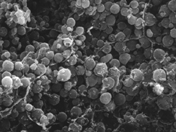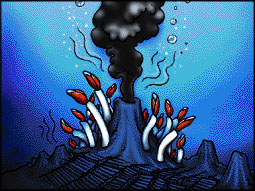Symbiont from the Deep: Microbes in Tube Worms from Deep Sea Thermal Vents
IMAGE
CREDIT: Colleen
Cavanaugh, Harvard University Image Width: 40
micrometers Microbe Name: not
yet known Click on
image to see bigger picture of this
microbe.

Symbiont from the Deep
These bacteria feed an animal that cannot eat. The relatives of this microbe make life possible deep beneath the ocean near volcanic vents. This particular microbe lives inside and feeds tall white worms sporting red, feathery caps, that live at the dark bottom of the sea.
|
Endosymbiosis The microbes and the worm depend upon each other for survival in what is called a symbiotic relationship. In a symbiotic relationship, two different species live together and each benefits from the partnership. In this case, the worm gives the bacteria a place to stay and the bacteria provide food for the worm. This worm, called Riftia pachyptila, is an unusual animal because it has no mouth or digestive tract and no apparent way to eat! Instead of eating food like other animals, Riftia allows bacteria to live inside of it and provide its food. The worms have a special feeding sac, called a trophosome, which provides the bacteria with shelter and ingredients to make food. In turn, the bacteria use these ingredients to make food for the worm. The trophosome and the bacteria inside it are so important that they make up over half the weight of this animal. |
|
Strange Life in the Dark
Dark ocean floors near deep sea vents are home to giant clams, shrimps, tube worms, crabs and other strange creatures. When these communities were first discovered living deep on the dark ocean floor, no one know how life could exist there without sunlight. Until recently, people thought that all food ultimately comes from plants and other photosynthetic creatures like algae and cyanobacteria. These photosynthesizers use energy from sunlight to convert carbon dioxide into food. Organisms that make food for an entire community are called primary producers. But who are the primary producers deep under water where there is no light?
Undersea Food Chain Based on Chemicals not Sunlight
The primary producers of deep sea vents are bacteria. These bacteria, like the ones in the picture above, get their energy from chemicals flowing out of the volcanic vents, not from energy found in sunlight.
Hydrogen sulfide, the stuff that smells like rotting eggs and is toxic to us, is one of the main chemicals used by the vent bacteria for making food. These bacteria make energy by combining hydrogen sulfide with oxygen (also supplied by the tube worms) to make sulfur, water and energy. The bacteria then uses this energy to convert carbon dioxide into food just like plants use energy from the sun to make food. This food in turn feeds the entire community of worms, clams, crabs and other creatures.
In the case of the tube worm, the bacteria living inside the worm use the hydrogen sulfide supplied by the worm. The worm collects the hydrogen sulfide with its red feathery cap. This cap is red because it is filled with blood containing a special hemoglobin that transports the hydrogen sulfide to the bacteria.
The tubeworm also provides the symbionts with oxygen which it needs to combine with the hydrogen sulfide for energy. This oxygen comes from the ocean surface. The tube worm provides the perfect place for bacteria to get both oxygen and hydogen sulfide which are often difficult to find in one place.
Microbe with no Name
Bacteria that live inside tube worms have no name yet. Like the majority of all microbes, this one has no name because it cannot be grown in the lab. Despite the difficulty of growing this microbe by itself, scinetists know a lot about this microbes physiology, ecology, and some of its DNA sequences.
Soon, this bacterium will be given a name and its relatives will be learned because of a new way to identify microbes. This technique, called DNA sequencing, allows scientists to take a small bit of DNA from the microbe in question, sequence it, and compare this sequence to all other known microbes. This microbe may be closely related to a bacterium we already know or it could be something completely new.
GLOSSARY:
bacteria - single celled organisms lacking a nucleus during their entire life cycle.
Calvin cycle - a set of chemical reactions that creates carbohydrates from carbon dioxide.
DNA sequencing - a technique of determining the sequence of A, T, G, and C from a bit of DNA. In determining a microbes identity, the section of DNA encodes a gene found in all living organisms, in this case the small subunit of the ribosome, the organelle used to make proteins.
carbohydrates - chemicals with the basic structure of CH2O. Sugar is a carbohydrate.
endosymbiosis - a relationship in which one organism (the symbiont) lives inside another (the host) and in which both partners benefit.
hemoglobin - a molecule found in red blood cells of your blood that carries oxygen to your body and is poisoned by hydrogen sulfide. In tube worms, hemoglobin floats freely in blood and is modified to carry both oxygen and hydrogen sulfide.
primary producers - organisms at the base of the food chain
symbiosis - The term "symbiosis" was originally coined by the German botanist Anton De Bary to mean "the living together of differently named organisms". A symbiosis can benefit both organisms (called mutualism) or one partner can hurt the other (parasitism) or the relationship can be anywhere in between. Over the years "symbiosis" has come to mean mutually beneficial, but biologists define symbiosis as it was originally intended. The Riftia/bacterium symbiosis would then be refered to as a "mutualistic symbiosis" a relationship in which both partners benefit versus just symbiosis. To not confuse young readers, the word symbiosis is used in the mutualistic sense.
symbiont - a partner in a symbiotic relationship
trophosome - Greek for feeding body, organ of tube worms where symbiotic bacteria live and produce food
For more information see: "Symbiosis in the Deep Sea" in Scientific American, vol. 256, 1987 by J.J. Childress, H. Felbeck and G.N. Somero.
Click here to see outline of microbes in Microbe Zoo
Dirtland || Animal Pavilion || Snack Bar || Space Adventure || Waterworld || Microbe Archive || ISME
© 1999 Comm Tech Lab, Michigan State University. This work was created with support from the National Science Foundation and the Center for Microbial Ecology at Michigan State University. Current maintenance is supported by the International Society for Microbial Ecology and the Comm Tech Lab.
This page last updated 10/1/99
